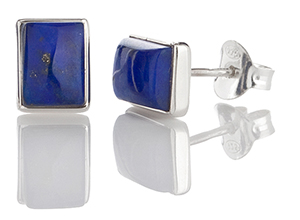
One of the oldest known gemstones, lapis lazuli has been mined from the same location in the Badakhshan Province of Afghanistan for over 6000 years. Coloured an electric blue by the mineral lazurite, lapis has had a wide variety of uses over the centuries including carvings, jewellery, inlays, sculptures and pigments. A typical misconception of this gemstone results in it often being classified as a rock rather than as a mineral like most other gemstones used in jewellery.
With an inconsistent chemical composition due to the range of minerals found within the stone, each specimen may have varying physical and optical properties and can look quite different. Although cherished by mankind for its opaque complexion and vivid blue colour, other desirable attributes are the flecks of white and gold due to calcite and pyrite. Other minerals found in this blue rock may be hauyenite, sodalite, diopside, mica and many more in far smaller quantities.
Predominantly mined in Afghanistan, lapis lazuli has also been commercially mined in Chile, Russia and smaller quantities in Siberia, Myanmar, Pakistan and Canada. Known for it’s protective properties, lapis ranks a low 5 to 5.5 on MOH’s scale of hardness making it the perfect material for carving and grinding into powders and has been discovered in ancient artifacts throughout the Middle-East, Egypt and South America.
The stone is famous for its association with the Ancient Egyptians. They regarded lapis lazuli as a holy stone with magical powers, reflecting both the life-giving waters of the Nile and the divine expanse of the sky. It was reserved for use only by the royals. Lapis was utilised in a number of ways, from scarab carvings, amulets, effigies, medicines and for the pigments of Cleopatra’s eye shadow!
King Tutankhamen’s death mask is one of the most memorable artifacts found in his tomb, the brass, gold and gem set mask was used to cover his linen wrapped head and shoulders. Inlayed around the eyes was none other than the vivid blue of lapis lazuli, however the blue-stripped hair was actually made with coloured glass. This confirms that the gemstone wasn’t easily available to the Ancient Egyptians given the 4000km distance between them and the source of the stone in Afghanistan, although the Pyramids suggest the Egyptians were never shy of a challenge.
Referred to as blue gold during the 14th to 17th centuries in Europe, lapis was a highly sort after material and in turn fetched a price worthy of gold. Travelling across land and sea to the artists with the biggest commission jobs during the Renaissance, the rock was ground to create an oil painting pigment appropriately named “ultramarine” in the most magnificent shade of blue. Due to its price and limited availability the pigment was used sparingly and often reserved for use on the Virgin Mary and Holy infant. Leonardo Da Vinci’s “The Virgin of the Rocks” is a perfect example of the stunning effect ultramarine can have to the overall aesthetics of an artwork.
In modern day 21st century pigments are synthesized and gemstones replicated, however the natural blue of lapis lazuli is still highly sought after for jewellery. Bunny Bedi, owner and Creative Director of Made In Earth discusses the ancient rock and its continuous popularity.
“When people wear a piece of lapis lazuli jewellery they are continuing a tradition that has going on for thousands of years. Its blue is still the most magical shade even compared to its synthetic/ treated counterparts. Our design team always strives to present the stone in new and exciting ways to continue a loyal following of the gemstone. Our stones are generally cabochon, flat tablets or faceted but recently we have added carved and raw lapis to our collection. The raw stones have a granular like surface texture and is a nice comparison to the highly polished silver work. The carvings almost remind me of the ways in which the Ancient Egyptians treated the stone in their jewellery and the pieces have been a nice change to the otherwise modern designs that we sell.”
From Cleopatra’s make-up case to Leonardo Da Vinci’s paintbrush this rock’s versatility transcends history. Celebrated for its beauty and prized for its colour lapis lazuli has hearts fluttering all over the world.